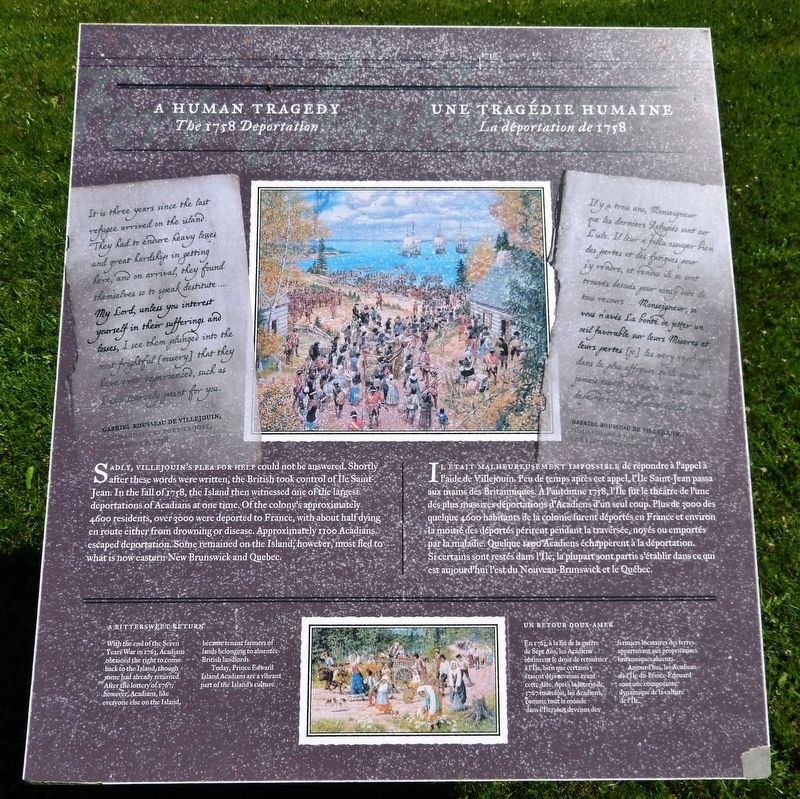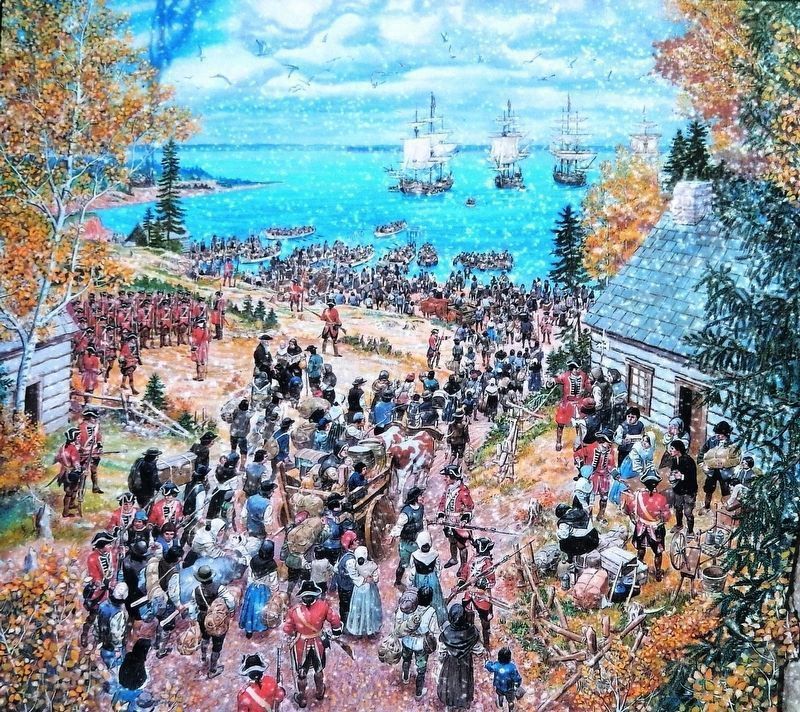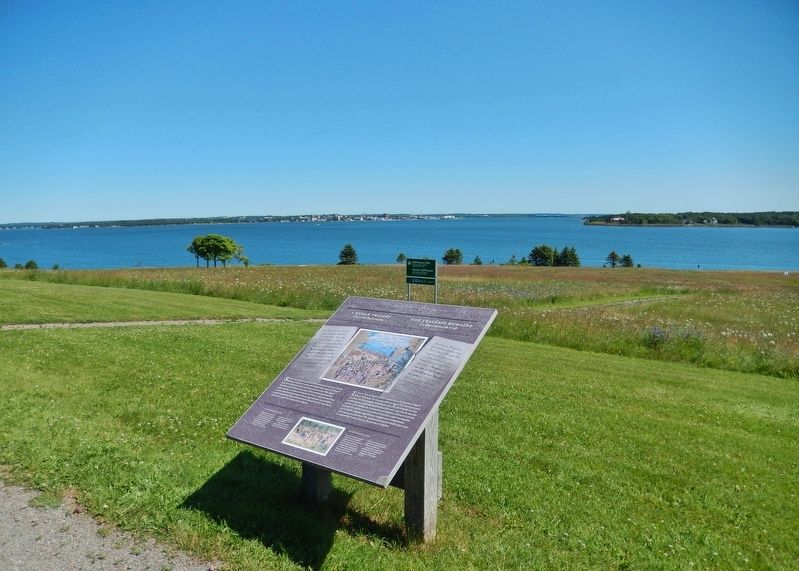Rocky Point in Queens County, Prince Edward Island — The Atlantic Provinces (North America)
A Human Tragedy / Une tragédie humaine
The 1758 Deportation / La déportation de 1758
”It is three years since the last refugee arrived on the island. They had to endure heavy losses and great hardship in getting here, and on arrival, they found themselves so to speak destitute… My Lord, unless you interest yourself in their sufferings and losses, I see them plunged into the most frightful [misery] that they have ever experienced, such as I can scarcely paint for you.”
—Gabriel Rousseau de Villejouin,
Commandant at Port-La-Joye,
September 8, 1758
Sadly, Villejouin’s plea for help could not be answered. Shortly after these words were written, the British took control of Île Saint-Jean. In the fall of 1758, the Island then witnessed one of the largest deportations of Acadians at one time. Of the colony’s approximately 4600 residents, over 3000 were deported to France, with about half dying en route either from drowning or disease. Approximately 1100 Acadians escaped deportation. Some remained on the Island; however, most fled to what is now eastern New Brunswick and Quebec.
A Bittersweet Return
With the end of the Seven Years War in 1763, Acadians obtained the right to come back to the Island, though some had already returned. After the lottery of 1767, however, Acadians, like everyone else on the Island, became tenant farmers of lands belonging to absentee British landlords.
Today, Prince Edward Island Acadians are a vibrant part of the Island’s culture.
« Il y a trois ans, Monseigneur que les derniers Réfugiés sont sur L’isle. Il leur a fallu essuyer bien des pertes et des fatigues jour s’y rendre, et rendus ils se sont trouvés denués jour ainsy dire de tous recours… Monseigneur, se vous n’avés La bonté de jetter un œil favorable sur leurs Miseres et leurs pertes [je] les very replongés dans la plus affreuse qu’ils ayent jamais essuyé, et que je ne peux vous de peindre aussy grande qu’elle sera. »
—Gabriel Rousseau de Villejouin,
Commandant à Port-La-Joye,
Le 8 septembre 1758
Il était malheureusement impossible de répondre l’appel à l’aide de Villejouin. Peu de temps après cet appel, l’Île Saint-Jean passa aux mains des Britanniques. À l’automne de 1758, l’Île fut le théâtre de l’une des plus massives déportations d’Acadiens d’un seul coup. Plus de 3000 des quelque 4600 habitants de la colonie furent déportés en France et environ la moitié des déportés périrent pendant la traversée, noyés ou emportés par la maladie. Quelque 1100 Acadiens échappèrent
à la déportation. Si certains sont restés dans l’Île, la plupart sont partis s’établir dans ce qui est aujourd’hui l’est du Nouveau-Brunswick et le Québec.
Un Retour Doux-amer
En 1763, à la fin de la guerre de Sept Ans, les Acadiens obtinrent le droit de retourner à l’Île, bien que certains y étaient déjà revenus avant cette date. Après la loterie de 1767 toutefois, les Acadiens, comme tout le monde dans l’Île, sont devenus des fermiers locataires des terres appartenant aux propriétaires britanniques absents.
Aujourd’hui, les Acadiens de l’Ile-du-Prince-Édouard sont une dynamique de la culture de l’Île.
Topics. This historical marker is listed in these topic lists: Colonial Era • Settlements & Settlers. A significant historical date for this entry is September 8, 1758.
Location. 46° 11.832′ N, 63° 8.168′ W. Marker is in Rocky Point, Prince Edward Island, in Queens County. Marker can be reached from Hache Gallant Drive, 1.2 kilometers east of Prince Edward Island Route 19, on the left when traveling east. Marker is located along the heritage trail at Skmaqn–Port-la-Joye–Fort Amherst National Historic Site. Touch for map. Marker is at or near this postal address: 191 Hache Gallant Drive, Rocky Point PE C0A 1H2, Canada. Touch for directions.
Other nearby markers. At least 8 other markers are within walking distance of this marker. The Grand Dérangement (a few steps from this marker); A Great Survey / Un Arpentage de Taille (within shouting distance of this
marker); The British Period / La période britannique (within shouting distance of this marker); Michel Haché-Gallant (within shouting distance of this marker); Port of Entry / Port d’entrée (about 90 meters away, measured in a direct line); The Mi'kmaq / Les Mi'kmaq (about 150 meters away); Place Yourself in History / Situez-vous dans l’histoire (about 180 meters away); Michel Haché-Gallant et Anne Cormier (about 180 meters away). Touch for a list and map of all markers in Rocky Point.
Related markers. Click here for a list of markers that are related to this marker. Skmaqn–Port-la-Joye–Fort Amherst National Historic Site
Also see . . .
1. Gabriel Rousseau de Villejouin. Villejouin had been in command at Île Saint-Jean (Prince Edward Island) for only a year when the deportation of Acadians from Nova Scotia led to a nearly disastrous influx of refugees. Villejouin actively and energetically dealt with the problems raised by the refugees. The fall of Louisbourg sealed the fate of Île Saint-Jean. Andrew, Lord Rollo, took possession of the island in August and all but 200 settlers, isolated on the western shore, were eventually deported. (Submitted on June 26, 2020, by Cosmos Mariner of Cape Canaveral, Florida.)
2. Expulsion of the Acadians (Wikipedia). On July 11, 1764, the British government passed an order-in-council to permit Acadians to legally return to British territories in small isolated groups, provided that they take an unqualified oath of allegiance. Under the deportation orders, Acadian land tenure had been forfeited to the British crown and the returning Acadians no longer owned land. Beginning in 1760 much of their former land was distributed under grant to the New England Planters. It was not until the 1930s, with the advent of the Acadian co-operative movements, that the Acadians became less economically disadvantaged. (Submitted on June 26, 2020, by Cosmos Mariner of Cape Canaveral, Florida.)
Credits. This page was last revised on June 26, 2020. It was originally submitted on June 23, 2020, by Cosmos Mariner of Cape Canaveral, Florida. This page has been viewed 117 times since then and 9 times this year. Photos: 1, 2, 3, 4. submitted on June 26, 2020, by Cosmos Mariner of Cape Canaveral, Florida.



